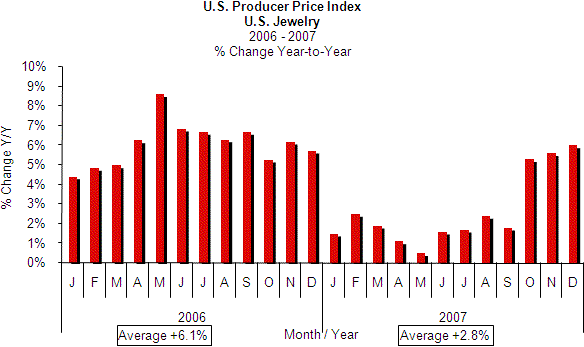IDEX Online Research: U.S. Jewelry Prices Continue to Surge in December, FY Prices Also Up Sharply
January 24, 08
U.S. jewelry prices at both the consumer level (retailers) and producer level (suppliers) continued to rise sharply in December 2007, primarily reflecting a surge in precious metals prices.
Unfortunately, based on an analysis by IDEX Online Research, neither jewelry suppliers nor retailers are passing along the full impact of commodity price increases through the distribution pipeline. Thus, we expect that merchants’ margins will remain depressed.
December 2007 – Jewelry Price Inflation
- Jewelry Producer Price Index +6.0% in December – U.S. jewelry producer prices surged by 6.0 percent in December 2007, the largest gain in 13 months, according to the Bureau of Labor Statistics (BLS). This leap in jewelry producer prices came on top of a large jump in December 2006; in other words, the compound price increase in jewelry at the supplier level is up double digit levels since late 2006. The sharp increase in jewelry suppliers’ prices in December was driven largely by dramatic increases in the price of gold and platinum jewelry.
- Jewelry Consumer Price Index +4.9% in December – U.S. jewelry consumer prices at retailers rose by 4.9 percent in December 2007, according to the BLS. IDEX Online Research believes that the only reason the jewelry prices at the retail level did not rise further or faster is because most stores’ prices in December were set in the late summer as holiday selling season promotional flyers were being prepared.
Full Year 2007 – Jewelry Price Inflation
- Jewelry Producer Price Index +2.8% in 2007 – For the full year, U.S. jewelry prices at the producer level rose by a moderate 2.8 percent, as calculated by the BLS. This reflects a very low inflation rate during the first nine months of the year. Jewelry price inflation surged in October among suppliers, a trend which continued through the end of the year.
- Jewelry Consumer Price Index +4.9% in 2007 – For the full year, jewelry prices at U.S. retailers rose by 4.9 percent, the largest gain in about 15 years. According to an analysis by IDEX Online Research, retail prices of jewelry should have risen by at least 7-8 percent for each of the past three years, if merchants passed along the full impact of higher commodity costs along with other rising business costs such as payroll, insurance, and other expenses. Instead, jewelry price inflation at the retail level has been up by only about 2 percent annually since 2005.
Among all consumer goods at the retail level, prices rose by 4.1 percent during 2007 in the U.S. Energy prices surged by 17.4 percent, while food prices rose by 4.9 percent. All other commodities (except food and energy) rose by a very modest 2.4 percent. Jewelry prices rose by 4.9 percent, somewhat above the average for all consumer prices (including energy and food), and rose far faster than all other commodities as a group.
Outlook for 2008 – Jewelry Prices Will Likely Surge
In our conversations with retailers and suppliers, the sentiment is unanimous: they can no longer absorb sharply rising costs. The first public announcement of this change in attitude came from Signet Group chairman Terry Burman during a conference call with Wall Street analysts recently. Burman said that Sterling would begin raising jewelry prices across the board just after Valentine’s Day.
He also noted that retail prices of some core items had not been raised in years. He issued this warning as a way of saying that Sterling’s sales could be affected negatively; shoppers who comparison-shop might find the same merchandise at lower prices in other stores. IDEX Online thinks Burman’s logic might be correct for a very short period, but it is inevitable that other merchants will raise prices… or run the risk of bankruptcy.
Our forecast for jewelry industry inflation in the U.S. in 2008 calls for the following:
- Jewelry Retail Prices +7% in 2008 – This would be the largest price increase in about two decades at the retail level.
- Jewelry Supplier Prices +7% in 2008 – This would be the largest increase in supplier prices since the BLS began keeping jewelry supplier PPI statistics in 1982.
Jewelry Producer Price Inflation Surges in December
Jewelry producer prices surged at the highest rate in 2007 during December. Producer prices were up by 6.0 percent versus December 2006. Unfortunately, jewelry producer prices surged by 5.7 percent in December 2006; thus, comparisons for the month of December 2007 were against one of the most difficult months in the prior year. In short, jewelry suppliers are finally passing along a significant portion their higher costs.
The graph below summarizes the monthly Jewelry Producer Price Index for inflation sine the beginning of 2006. The figures are based on year-to-year comparisons of the BLS Jewelry Producer Price Index.
|
|
While the inflation rate for all jewelry at the producer level was up sharply in December, it was driven primarily by higher precious metal costs. The BLS provides some limited segment information which shows that producer prices for gold (and other precious metals) jewelry surged by 8.2 percent in December 2007, the same rate as November. Gold jewelry represents more than 90 percent of this Precious Metals Producer Price Index.
The graph below compares the inflation rate for “all jewelry” (red bar) versus the inflation rate for “gold and precious metals jewelry” (gold bar). It is clear that inflation of precious metal jewelry is a key component which is pushing up the inflation rate for all jewelry.
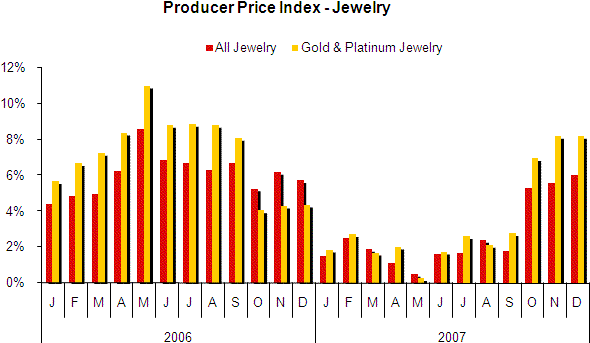
Source: BLS
Jewelry Retail Price Inflation: Up, Up, Up
Retail prices for jewelry had been on a roller coaster ride earlier in the year. However, for the final four months of 2007, monthly inflation rates were steady and very high. Now that jewelry suppliers have opened the floodgates with sharply higher prices, retail jewelers have no choice but to raise prices. As mentioned earlier, Sterling Jewelers, which operates Kay Jewelers, Jared, and a stable of regional brands, has announced that it plans to reprice its entire line of jewelry just after the Valentines selling period in 2008.
The graph below summarizes the percentage change in retail prices of jewelry and watches by month on a year-to-year basis since 2006. The percent change is based on a comparison of the same month a year ago.
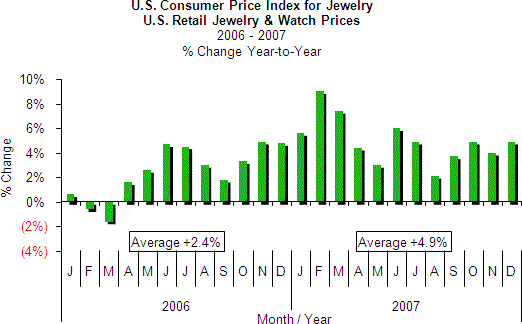
Source: BLS
Outlook for 2008: Sharply Rising Jewelry Prices
It was inevitable that both jewelry suppliers and jewelry retailers would be forced to raise their prices to reflect the full impact of higher costs. We are surprised that it has taken so long. However, in the jewelry industry, no one has pricing power, except at the mining level. Because the industry is so fragmented, both at the supplier and retail level, no single merchant has the ability to set prices and expect others to follow.
IDEX Online Research recently completed an analysis of jewelers’ costs over the past three years. We found that merchants costs have risen an average of about 7-8 percent annually, when materials, labor and overhead expenses were properly allocated across their financial operating model. This may seem low, based on the surging price of precious metals, but diamond prices, especially at the mass market level, have not shown any significant price inflation; diamonds represent about half of specialty jewelers’ sales.
Over the same three-year period, jewelers’ retail prices have risen by a modest 2 percent annually. By “back of the envelope” calculations, an immediate 15 percent “catch-up” price increase must be implemented, just to bring merchants even with current cost levels.
If significant commodity inflation persists in 2008, as we expect, prices throughout the jewelry distribution pipeline will continue to rise.
The following graph summarizes the forecast for Jewelry Producer Prices in 2008 versus prior years’ inflation rates.
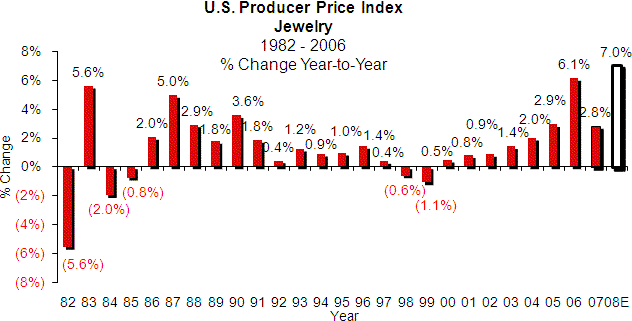 Source: BLS |
The following graph summarizes the projected price increase at retail for jewelry in the U.S. market during 2008.
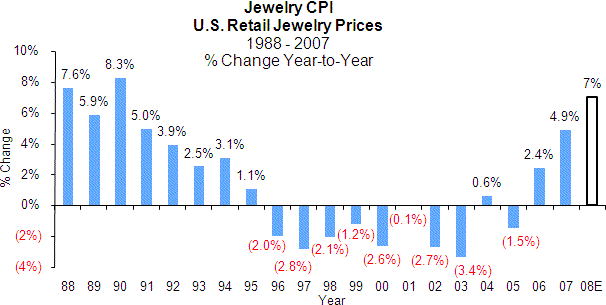 Source: BLS |
If you are thinking that it will be an interesting year for jewelry prices – watching who will be the first to raise prices significantly – you are right. No one wants to be the first, nor the last. But, as in the game of musical chairs, someone will be left out when the music stops.
